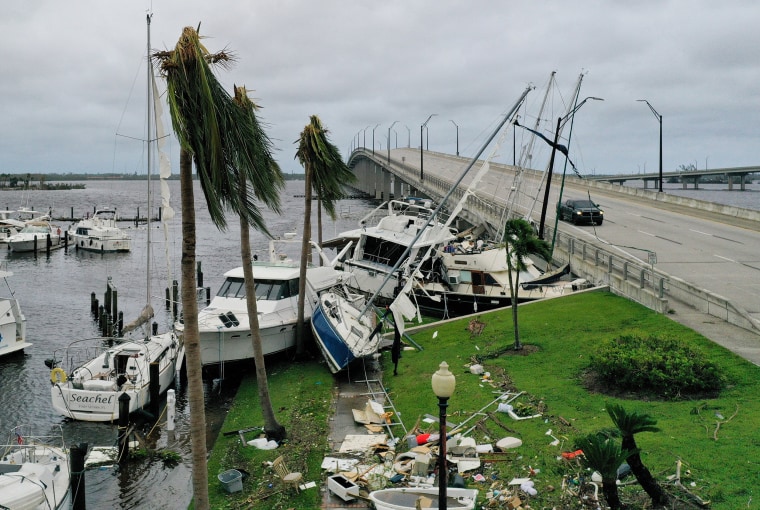At least 10 people have died after Hurricane Ian tore across Florida with such ferocity that President Joe Biden said it could be the deadliest in state history.
Speaking after a briefing with Federal Emergency Management Agency officials Thursday morning, Biden said that while the death toll remained unclear, early reports suggest the loss of life could be “substantial.”
“I spoke with the commissioners, and they are worried,” he said.
As of Thursday evening, 10 people had been confirmed dead in the storm, with seven of them in Charlotte County, an area near the stretch of southwest coast where Ian made landfall Wednesday afternoon.
Speaking on MSNBC, Charlotte County Commissioner Christopher Constance attributed six of the fatalities to a county administrator. He later confirmed a seventh death.
Two people died in Sarasota County, a sheriff’s spokesperson there said, and one person drowned in Volusia County while trying to drain his pool, local law enforcement officials said.
Additional details about the victims were not immediately available.
One of the most powerful storms to ever hit the United States, Ian left roughly 2.3 million customers without power as of Thursday afternoon. Several hospitals had no water, and thousands of residents were trapped in their homes.
Fort Myers Mayor Kevin Anderson told NBC's "TODAY" show that Ian was one of the most ferocious storms he had witnessed in decades, gutting him emotionally.
"Watching the water from my condo in the heart of downtown, watching that water rise and just flood out all the stores on the first floor, it was heartbreaking," he said.
Photos and videos on social media showed the scenes of devastation: Orlando inundated by floodwaters, boats wrecked in Fort Myers, trees snapped like toothpicks in Punta Gorda. Part of the Sanibel Causeway was destroyed, blocking vehicles from crossing the bridge.
DeSantis said the storm would rank as "one of the top five hurricanes to ever hit the Florida peninsula.” Biden declared a major disaster, freeing up federal aid to assist with local and state recovery efforts.
Ian heads north
Ian was downgraded to a tropical storm Thursday morning before strengthening again to a hurricane and "taking aim at the Carolinas and Georgia with life-threatening flooding, storm surge and strong winds," the National Hurricane Center said.
Ian had maximum sustained winds of near 75 mph with higher gusts Thursday night as it headed for South Carolina, where it was forecast to hit Friday, according to the National Hurricane Center.
The state's entire coastline was under a hurricane warning, the center said.
Para información en español de Noticias Telemundo haga click aquí
Ian made landfall near Cayo Costa, Florida, around 3 p.m. Wednesday as a powerful Category 4 hurricane with 150 mph winds, forecasters said.

On Wednesday night, Lee County Manager Roger Desjarlais said the damage is extensive in the county, which includes Cayo Costa, Fort Myers and Cape Coral.
Rescue crews were forced to wait for conditions to improve before going to the aid of people stranded by high water.
In Lee County, there were also reports of vehicles "floating out into the ocean," but Sheriff Carmine Marceno said officials were not able to investigate or respond to calls of people trapped until winds dropped below 45 mph.
“Those that are in need: We want to get to you, and we will get to you as soon as possible," he said in a video address shortly before 8 p.m.
At least nine hospitals in Lee County had no water after the storm made landfall on Florida’s southwest coast, Federal Emergency Management Agency Administrator Deanne Criswell said Thursday.
'We are trapped'
Terry Mazany hunkered down on the 22nd floor of a Fort Myers high-rise with his wife and his 91-year-old mother as the water rose and winds whipped the building.
“We are trapped. There is eight feet of water around us,” Mazany, who moved to Florida from California a year ago, told MSNBC. He noted that the elevators were also shut down.
"It started relatively manageable, but the last 12 hours we have dealt with that freight train of 100-plus mile an hour winds shaking the building, swaying," he said.
Central and northeast Florida were expected to see 20 inches of rain, and life-threatening storm surge remained a risk for parts of Florida’s western and eastern coasts Thursday, the hurricane center said.
Florida’s Atlantic coast from northeast of Orlando into Georgia could see storm surge of 6 feet, it said.
Radar indicated that 4 to 5 inches of rain per hour was falling in the hurricane’s heavier bands Wednesday, said Jamie Rhome, the acting director of the hurricane center.
“Those are incredibly heavy rainfall rates,” Rhome said Wednesday night on MSNBC. The storm’s slow speed was prolonging the damaging wind but also increasing the potential for flooding, he said.
Experts have not directly linked the storm's strength to climate change, but its rainfall projections fit within a broader trend of storms becoming rainier as the climate warms, allowing the atmosphere to hold more moisture.
As the storm turns north and heads for the Carolinas, the governors of Georgia, South Carolina and North Carolina have declared states of emergency ahead of the storm’s arrival.


